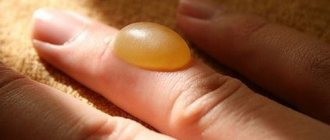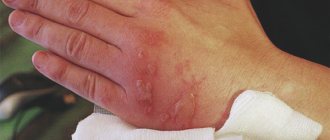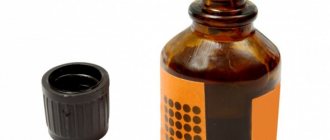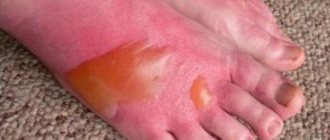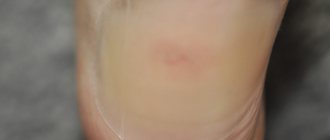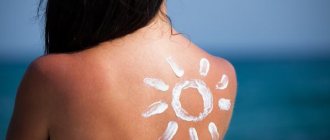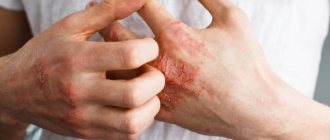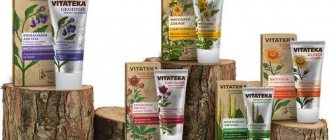A hot oil burn should be treated based on the specifics of this serious and painful injury. The boiling point of fats is very high, so even a drop of hot mass on the skin does not go unnoticed. Unlike water, oil forms an airtight film that does not allow the affected surface to cool quickly, thereby injuring it even more. In this case, it is extremely important to provide correct first aid.
Specifics of injury
A burn is a protective reaction of the skin in response to an aggressive external factor. By forming a blister, the body tries to cool and protect the overheated area of the epidermis.
Based on the nature and extent, thermal burns of any origin are divided into 4 degrees.
Since the last, 4th degree, implies deep damage, reaching the muscles and bones under the influence of very high temperatures, it is excluded from the list of oil damage at home.
To determine the level of injury, you need to focus on the following external signs:
- in grade 1, the skin at the site of the lesion turns red, painful swelling and swelling are formed, which do not require special treatment. They pass quickly, but need careful handling;
- Stage 2 is characterized by the appearance of watery blisters - both small and large. After opening, wounds form in their place, which heal within 10-15 days. They are very painful, so if the lesion is extensive, a person may experience shock and even lose consciousness. Significant injuries require immediate hospitalization of the patient;
- 3rd degree burns include burns that violate the integrity of not only the epidermis, but also the subcutaneous fat. Nerve endings and blood vessels are also affected. The consequences of such an injury are extremely painful. Necrosis begins, in which scabs of soft tissue form and exudate mixed with blood is released.
Open wounds provide easy access to infections and bacteria. They should only be treated by a qualified specialist. Surgery may be necessary to prevent the development of sepsis.
An oil burn is one of the most common household injuries caused by cooking and heating food.
In the absence of knowledge on how to provide assistance, even stage 1 lesions can become infected, begin to fester, cause serious inflammation and subsequently leave deep scars. Stage 3 damage from vegetable oil is extremely rarely diagnosed.
Basically, these are cases when a person inadvertently knocked over a container of boiling fat.
Forbidden
What to do if you burn your finger is prohibited?
- Lubricate the burned area with hydrogen peroxide.
- Apply iodine or brilliant green directly to the burn.
- Treat the area itself with alcohol.
- Lubricate the affected area with vegetable oil.
It is advisable that your home medicine cabinet contains special products that will help relieve pain from a burn and speed up its healing: Panthenol, Levomekol, Solcoseryl, etc.
Thermal injuries vary in area and severity. If the burned part is more than 10% of the skin, then the victim requires immediate hospitalization. 1% of the skin is considered to be an area the size of a human palm, and to determine the size of the burn, the patient’s hand is usually applied to the wound surface.
When to call an ambulance
Grade 2 and above require qualified medical care. 1st degree burns can be treated independently at home.
You should definitely call an ambulance if:
- the victim is a child, an elderly or seriously ill person, a pregnant woman;
- the person has lost consciousness or is in a state of shock;
- the head, face, groin or abdominal area are burned.
Before doctors arrive, it is important to provide first aid using home remedies correctly. If the person nearby does not have the necessary knowledge, it is better to wait for a doctor so as not to cause even more harm.
Before his arrival, it is necessary to give the victim water to drink, and in case of severe pain, give an analgesic. This is the only medicine that is allowed to be used. You must inform the arriving physician about taking the medication.
First aid: do's and don'ts
The algorithm of actions depends on the degree of damage and severity of the injury:
- The first step is to cool the burned area. To do this, it is best to use a stream of cool, but not icy, water. This will stop the heating of the skin, the development of inflammation and the process of destruction of deep tissues. For burns of 2nd degree or higher, ice should not be used for such purposes: a sharp change in temperature will further injure the epidermis and cause severe pain . Ice may be applied by wrapping it in cloth only if the damage is minor.
- Burnt skin should not dry out. For this purpose, a special medical bandage (for example, Apollo) is applied to the affected area. It is rarely present in a home medicine cabinet, so it can be replaced with cling film, but in no case with ordinary cloth: the lint will stick to the wound and, when removed, injures it even more. In addition, such non-sterile dressings can cause infection.
Before receiving medical attention, the film can only be applied to a cooled surface and for a short period of time, as it does not allow air to pass through.
In this case, you need to make sure that the inflamed tissues are not pressed. If there are no blisters or wounds, no dressing is required. When providing assistance, it is not allowed:
- open blisters that have formed;
- lubricate the damage with fatty products in the form of sunflower or butter, sour cream, glycerin, petroleum jelly, cream;
- remove clothing from the victim that is stuck to the injury site;
- apply tight bandages;
- wipe wounds with cotton wool, cloth or paper napkins.
If an oil burn causes chills in the victim, he should be carefully wrapped in a towel or blanket so that the fabric does not touch the injured areas. If the patient loses consciousness, apply a cold compress to the forehead or lower the limbs into a container with lukewarm water.
Sprays and ointments
Anti-burn agents are selected depending on the degree of damage. For grades 1-2, the following medications may be used during first aid:
- Panthenol – accelerates tissue regeneration and prevents scarring. Used for all types of burns - solar, oil, chemical;
- Olazol – soothes pain, disinfects the surface, accelerates skin healing;
- Solcoseryl - activates tissue repair, ensures the transport of oxygen into cells, promotes the process of wound closure, and prevents the formation of scars.
The most convenient forms of drug release are spray and foam (mousse). When applying them, tactile contact with the burned area is not required, which eliminates additional pain and infection.
Traditional medicine recipes
Burns can be treated using home remedies for grade 1 severity, mild grade 2 injuries (in the presence of single small blisters) and after discharge from the hospital, where the patient was treated for extensive damage.
There are many different recipes that restore tissue and relieve inflammation. The most effective of them are the following:
- Grind the boiled egg yolk of 2-3 eggs until smooth. Simmer the resulting mush in a hot frying pan over low heat. Collect the released fatty mass, cool it and use it as an ointment for long-term non-healing wounds. When frying, the yolk gives off an unpleasant odor and smokes heavily. Therefore, it is best to prepare the product outside or with the windows wide open and the hood on. This medicine is very effective: it accelerates the process of cell regeneration, prevents the appearance of scars .
- It is recommended to apply aloe pulp to the burned area or lubricate it with plant juice. The product disinfects, softens, moisturizes the epidermis and stimulates tissue restoration.
- Even a prolonged burn continues to hurt for a long time. A potato compress will help get rid of discomfort and quickly relieve swelling. The raw root vegetable must be grated on a fine grater. Place the mixture in gauze, squeeze lightly and apply to the affected area for 20-30 minutes 3-4 times a day. Grated pumpkin is used in the same way.
- Cabbage leaves prevent suppuration, promote the resorption of fluid formations and effectively eliminate inflammation. The sheet should be rinsed well with hot water, all hard veins should be removed, crushed with a rolling pin and applied to the damaged area. Secure the cabbage with a bandage or gauze. Change the sheet 3-4 times a day.
For open, oozing wounds, the use of traditional methods is contraindicated. This can provoke infection and the development of serious consequences.
As antiseptics, it is recommended to use a solution of Chlorhexidine, Miramistin or Furacilin diluted in warm water (1 tablet per 200 ml). The powder from crushed tablets of Streptocide promotes healing and drying of the wound.
Got burned by the fire
What to do if you burn your gloved finger near a fire? First you need to extinguish the flame on the glove, and to do this you need to block the access of oxygen to the fire. For example, immerse your hand in the ground, sand, water or snow. The remnants of the glove must be carefully removed from the hand, without tearing off the stuck fabric. Next, you should cool the burned area. After this, it is recommended to apply any anti-burn agent and apply a bandage. After taking all these measures, you need to go to the hospital so that the doctor cleans the wound of any remaining tissue and rinses it. What should you do if you burn your finger and there are no remedies or sterile gauze nearby? In such cases, after you have cooled the affected area, you need to apply a bandage made from clean clothes, a scarf, or a scarf. This will prevent infection from entering the wound. The main thing is not to panic in the current situation. After all, this can harm the victim.
Post-burn therapy
Thermal oil injuries are treated in the same way as regular burns: the surface is periodically treated with antiseptics, then a wound-healing anti-inflammatory agent with a moisturizing effect is applied. For painful sensations, analgesics are taken. In severe cases, antimicrobial drugs are prescribed for internal use.
The most effective and safe ointments are:
- Rescuer;
- Levomekol;
- Depanthol;
- Pantestin;
- Vitaon.
For daily post-burn therapy, it is enough to smear the damaged surface with the selected drug and allow it to be completely absorbed without using bandages.
Each medication has its own contraindications, restrictions on the number of applications and the duration of the treatment course. Therefore, you should not use them without the approval of a doctor and without reading the instructions.
Burn with essential oil
The oil doesn't have to boil to cause a burn; even cold essential oils can damage your skin. This product is widely used in the treatment of various diseases and for cosmetic purposes. But not every person knows how to use it correctly. Quite often, esters are confused with basic vegetable fats and are applied undiluted to the skin indefinitely, which leads to burns, dermatitis, irritation and other damage to the epidermis.
To avoid getting burned by essential oil, you should follow the rules for its use:
- Be sure to study the instructions included with the product, it is especially important to pay attention to contraindications;
- do not apply oil to mucous membranes;
- do not use ether undiluted;
- Before use, do an allergy test - apply a drop of the extract to your wrist or inner surface of the elbow and monitor the skin reaction.
You can treat a burn from essential oil with lotions made from green tea, potato juice, aloe, or use the same pharmaceutical ointments as for thermal injuries.
If ether gets into your eyes, rinse them with plenty of running water and immediately consult an ophthalmologist to prevent damage to the cornea and pupil.
Burnt finger child
Many mothers have encountered situations where a child touched a hot pan, kettle or iron. What to do if a small child burns his finger? The procedure should be absolutely the same as in the case when an adult was injured. You can apply ointments that will numb the burn area to calm your baby. Talk to him, don't raise your voice.
Apply a bandage so that the victim does not have access to the burn, reassure and distract the child from what happened. In cases of severe tissue damage, consult a doctor immediately.

